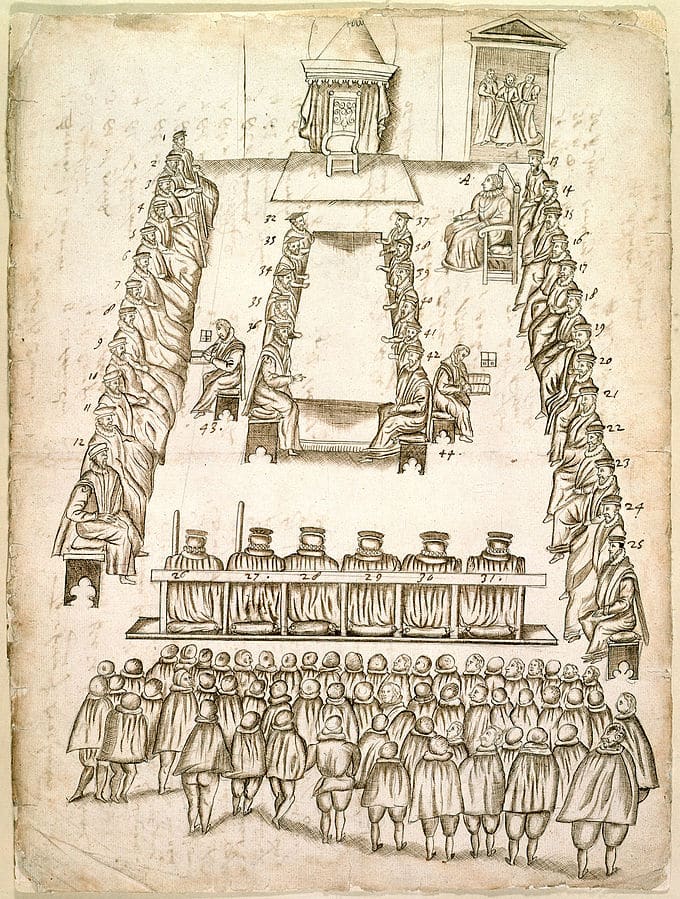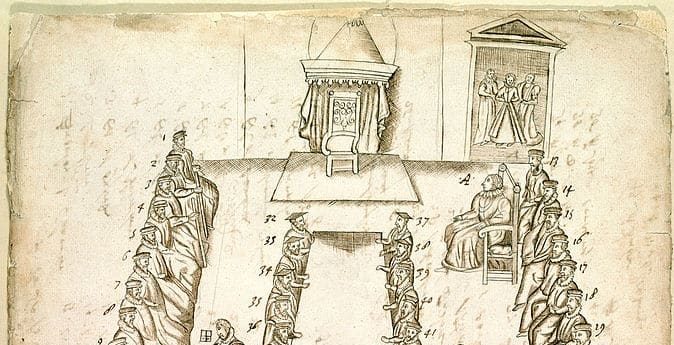
After Mary Stuart wrote her fateful letter (I did a separate post about it, you can read it here), Elizabeth had little choice but to bring her to trial. And while everyone agrees that she represented herself magnificently, the prosecution had been careful enough in amassing its evidence that she could not overcome the inevitability of conviction. Not that she didn’t try!
First, she denied everything: she repudiated any suggestion that she had known Anthony Babington, let alone corresponded with him. She made much of the fact that the prosecutors did not have her original letters, only copies (because Walsingham made sure that the letters were carefully and resealed sent on after being intercepted, deciphered, and copied – to keep the chain of communication going so they could assemble evidence against the conspirators). And when faced with the confessions of her two secretaries – recorded independently and not under torture – she shrugged it off (“If they have written anything prejudicial to the Queen my Sister, they have written it altogether without my Knowledge, and let them bear the Punishment of their inconsiderate Boldness”).
Interestingly on the second day of the trial, the prosecution got granular: they parsed Mary’s “alleged” reply to Babington, getting her to abandon her “I never heard of this guy” defense and make fatal mistakes. First, they pointed to the language where she “allegedly” consented to Elizabeth’s assassination: “then it will be fit to set the six gentlemen to work, taking order upon the accomplishment of their designs.” Although Mary tried to argue the “work” and “designs” were something completely different, when you read her letter together with Babington’s, there could be no doubt what she was talking about… Second, Mary had also appealed for foreign help – an act of war. Although she argued that this was a legitimate move for her as a queen, this was textbook treason (all you had to do was look at the charges: that she “conspired the destruction of [the Person of the most Serene Queen Elizabeth] and the Realm of England, and the Subversion of Religion”).
But I digress. Once the evidence had been presented, the trial was adjourned so the commissioners could return to London where they met at the Star Chamber in Westminster. While they were there, Mary’s two secretaries appeared before them in person to confirm the statements they had given about her letters…The verdict was inevitable (though not unanimous – twenty-year-old Lord Edward Zouche was the one dissenting vote (fun fact: if you go to Wikipedia to find out more about him, you will see that this is one of only two things he is remembered for, the other being that he organized a stag-hunt where his guest, the Archbishop of Canterbury, accidentally killed a man).
(For further reading: Jane Dunn’s Elizabeth and Mary: Cousins, Rivals, Queens is amazing, as is John Guy’s My Heart is My Own: The Life of Mary, Queen of Scots)
***
If you like my posts, you’ll love my books! My Seymour Saga trilogy tells the gripping story of the short-lived dynasty that shaped the Tudor Era. Jane the Quene skews romantic, The Path to Somerset is pure Game of Thrones (without the dragons), and The Boy King is a noir coming-of-age. Get them now through Amazon, Barnes & Noble, Kobo, and Apple, or even your local independent bookstore!

(PS Already read them? Did you love them? Then please review them – even just a stars rating! It makes a huge difference in helping new readers find them and would mean the world to me!)

Thomas Salusbury (David Hugh Bottrill’s candidate for Shakespeare) became involved in the Babington Plot because QE I’s dad had had his grandmother killed in a final mad fit of dynastic cleansing. Salusbury’s role was tipped to Walsingham by Christopher Marlowe who seems to have been Salusbury’s gay literary friend/lover, and Elizabeth ordered his arrest and execution. He was arrested but escaped execution and fled to Spain (possibly Andorra, where his early literary efforts with Marlowe may possibly still be found), and only returned to England after 7 years when the heat had died down and under a different name (Thomas Heywood). Somewhere in Heywood’s >200 plays there must lurk a disguised description of this adventure. Christopher Marlowe was killed in the famous bar fight soon after Salusbury/Heywood’s return to Merrie England.
I heard from someone in Somerset that the documents used to convict Mary Stuart were found in the 20th Century in the attic of a house near Taunton, once owned by a Solicitor who was gifted the house following the conviction. Is any of that true ?
What an amazing story! I had not heard that!